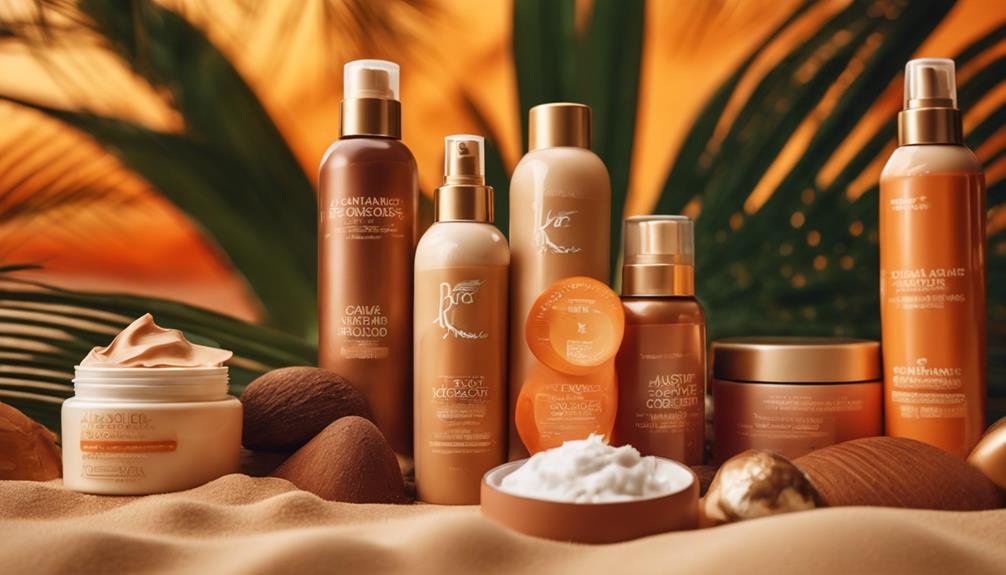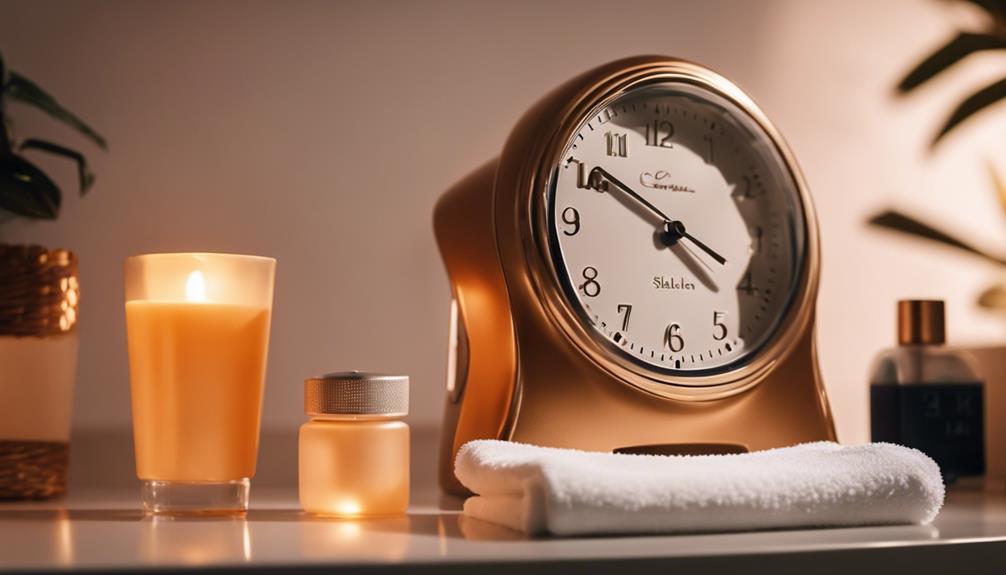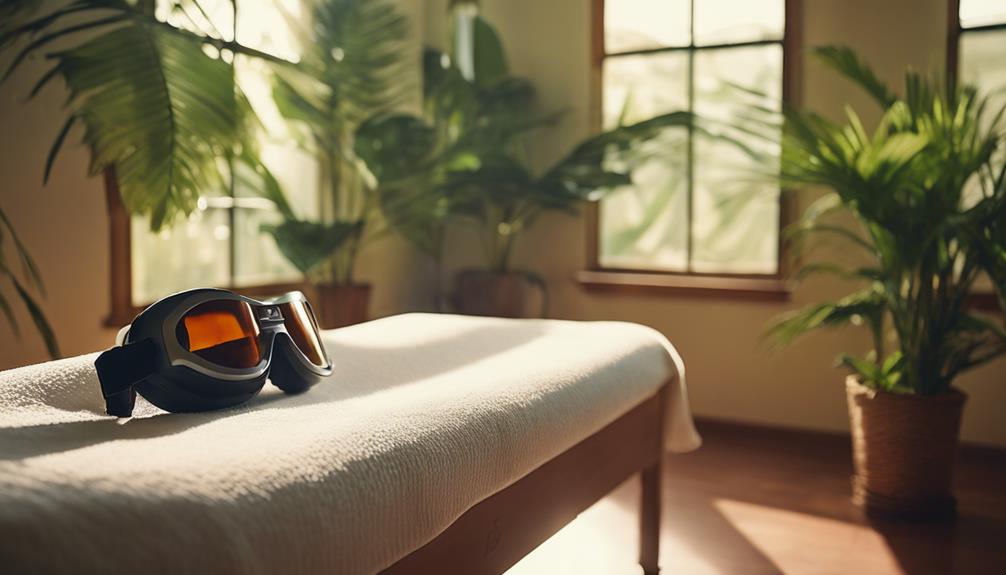If you want a radiant tan without risking your skin, try sunless tanning products. Self-tanning lotions, like Bondi Sands Dark Self Tanning Foam, offer a natural glow without UV exposure. You can also choose customizable spray tans for a streak-free finish or temporary bronzing powders for instant color. Don't forget to exfoliate before applying to guarantee an even layer. Follow up with daily moisturization to maintain that beautiful tan. With so many safe options available, you can confidently flaunt your glow while protecting your skin. There's so much more to discover about achieving that perfect tan!
Key Takeaways
- Self-tanning lotions and sprays provide a radiant tan without harmful UV exposure, reducing skin cancer risks and premature aging.
- Products like Bondi Sands Dark Self Tanning Foam and Coco & Eve Self Tanner Mousse offer easy application for natural-looking results.
- Exfoliate and moisturize before application to ensure an even, long-lasting tan that enhances your natural beauty.
- Use tanning mitts for seamless blending and to prevent stained hands during the application process.
Risks of Tanning Beds
Tanning beds pose significant health risks, including a drastically increased chance of developing skin cancers like squamous cell carcinoma and melanoma.
When you use tanning beds, you're exposing yourself to UVA rays that are 3-6 times more intense than natural sunlight. This exposure can lead to a 58% higher chance of squamous cell carcinoma and a 24% increase in basal cell carcinoma. If you start tanning before age 20, your risk of melanoma jumps by 47%.
Additionally, the UV rays may cause premature aging, resulting in wrinkles, age spots, and a leathery skin texture. Your skin may also lose firmness and develop stretch marks due to this damage.
It's essential to think about these significant risks before opting for tanning beds.
Benefits of Sunless Tanning
Choosing sunless tanning products allows you to achieve a beautiful, radiant glow without the harmful effects associated with tanning beds.
These products help you avoid UV exposure, reducing your risk of skin cancer and premature aging.
With sunless tanning, you can customize your shade to match your skin tone, ensuring a natural look that enhances your features.
The application is straightforward, allowing you to achieve a salon-quality tan in the comfort of your home.
Plus, many sunless tanners are infused with skin-loving ingredients, promoting hydration and overall skin health.
You'll enjoy a stunning tan that lasts without the worry of damage, making sunless tanning a smart choice for maintaining your glow safely.
Popular Self-Tanning Products

When it comes to achieving a gorgeous glow, several popular self-tanning products stand out for their effectiveness and ease of use.
Self-tanning lotions, like Bondi Sands Dark Self Tanning Foam, utilize DHA to deliver a natural tan without harmful UV exposure.
If you prefer a professional touch, consider spray tans, which offer a streak-free finish and can be customized for your desired shade.
For an instant glow, temporary bronzing powders are perfect; they wash off easily and let you control the depth of color.
Each option allows you to achieve that radiant look while keeping your skin safe.
Remember to exfoliate and moisturize before application for the best results!
Natural Sunbathing Options
For those who prefer the sun's warmth while avoiding harmful UV rays, natural sunbathing alternatives can help you achieve a beautiful glow safely.
Self-tanning lotions and sprays are excellent options, allowing you to enjoy a bronzed look without the risks associated with traditional tanning. Products like Bondi Sands Dark Self Tanning Foam and Coco & Eve Self Tanner Mousse Kit offer easy application and long-lasting results.
If you're looking for a vegan option, try Ultra Natural Bronze Self Tanner Mousse, infused with coconut oil for added skin health.
These products provide a radiant tan that enhances your natural beauty while protecting your skin from UV damage. Enjoy the warmth and glow without the worries of sun exposure!
Application Techniques for Best Results

Mastering the right application techniques can make all the difference in achieving a flawless and even tan with self-tanning products.
Start by exfoliating your skin to remove dead cells, ensuring a smooth canvas. Apply a light moisturizer to dry areas like elbows and knees to prevent uneven absorption.
Use a tanning mitt for self-tanning lotions or mousses; it helps distribute the product evenly and keeps your hands stain-free. Work in sections, applying in circular motions for a seamless blend.
For spray tans, wear protective eyewear and hold the nozzle about six inches from your skin. After application, avoid sweat and moisture for at least a few hours to allow the tan to develop fully.
Tips for Maintaining Your Tan
To keep your tan looking vibrant and fresh, proper aftercare is essential.
Start by moisturizing daily to prevent dryness, which can cause your tan to fade unevenly. Choose a hydrating lotion or oil that's free from harsh chemicals.
When showering, use lukewarm water and limit exfoliation to once a week to maintain your color. Avoid long hot baths or saunas, as they can strip your tan faster.
If you're using self-tanning products, apply a gradual tanning lotion to extend your tan's life.
Additionally, protect your skin from chlorine in pools by rinsing off immediately after swimming.
Common Myths About Tanning

Many people believe that a base tan protects against sunburn, but in reality, it offers minimal protection and can still lead to serious skin damage. Here are some common myths about tanning you should know:
| Myth | Truth | Impact on Skin |
|---|---|---|
| A base tan prevents sunburn | Minimal protection, serious damage risk | Increased risk of skin cancer |
| Tanning beds are safe | Emit intense UVA rays | Higher cancer risk |
| Darker skin means less damage | All skin types can be harmed | Misleading sense of security |
| You can't get burned on a cloudy day | UV rays penetrate clouds | Sunburn is still possible |
| Tanning is healthy | UV exposure causes skin issues | Premature aging and damage |
Educate yourself on these myths to protect your skin!
Frequently Asked Questions
Can I Use Sunless Tanner on My Face?
Yes, you can use sunless tanner on your face! Just choose a product specifically designed for facial use, and make sure to apply it evenly for a natural, radiant finish without streaks or patches.
How Long Does a Spray Tan Last?
A spray tan typically lasts between five to seven days, depending on your skin type and aftercare. To extend its life, moisturize regularly and avoid excessive sweating or water exposure. Enjoy your beautiful glow!
Are Self-Tanners Safe for Sensitive Skin?
Are self-tanners safe for sensitive skin? Yes, many self-tanners are formulated for sensitive skin, but you should always check the ingredients. Test a small area first to guarantee you don't have an adverse reaction.
Can I Tan Over a Tattoo?
You can tan over a tattoo, but it's best to be cautious. UV exposure might fade the ink and alter the design. Consider using sunscreen on the tattooed area to protect it while tanning.
How Do I Remove Self-Tanner if Needed?
Imagine trying to erase a chalk drawing on a rainy day. To remove self-tanner, gently exfoliate your skin with a scrub or apply a baking soda paste, ensuring you restore your natural glow without harshness.
Conclusion
Embracing sunless tanning is like discovering a hidden treasure chest of beauty.
With safe alternatives at your fingertips, you can achieve that golden glow without risking your skin's health.
Remember, whether you choose self-tanners, professional sprays, or bronzing powders, the right techniques and care will keep your radiance shining bright.
So, wave goodbye to tanning beds and welcome a healthier, luminous you, where your skin glows as brilliantly as the sun without any of the harmful rays.










